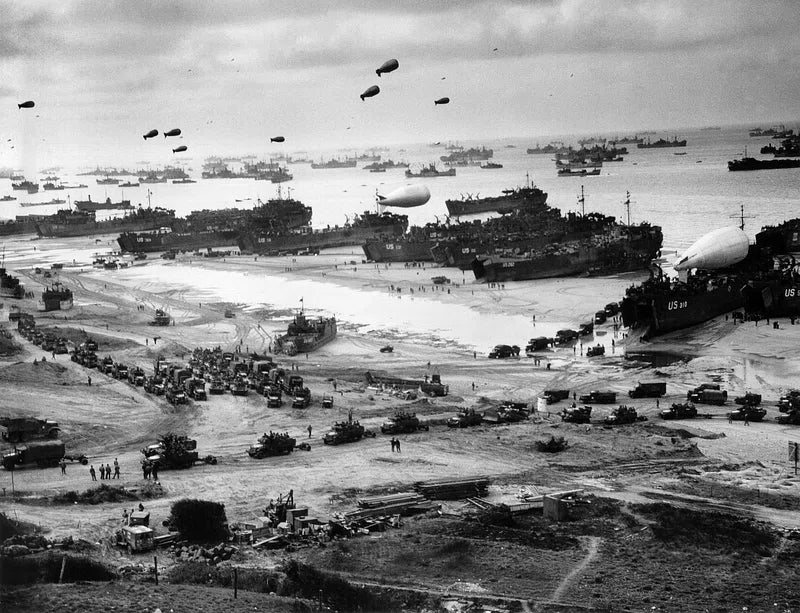The fate and future of the entire world changed in one day. The world, ravaged by war and violence, was itself revolutionized by one specific day of violence. On the sixth day of the sixth month in 1944, the Allied nations executed D-Day. While there is debate as to what the phrase "D-Day" actually means, there is no dispute as to its importance in world history.
WWII’s D-Day was one of the most complex military operations ever planned. It was the largest amphibious invasion in history. On that day, 156,115 troops landed in Normandy, France, while another 23,400 flew in the skies above to provide cover. In addition to a staggering number of troops involved, there were 11,590 Allied aircraft that supported the invasion and 6,939 naval vessels (dod.defense.gov). It is important to note that sources differ a moderate amount in the number of troops and equipment used.
Secrecy and Strategy
Codenamed “Operation Overlord,” D-Day took almost a year of planning. At the Tehran Conference in August of 1943, President Roosevelt, Winston Churchill, and Joseph Stalin agreed to begin planning an attack on Western Europe. Axis forces controlled France, keeping Allied forces from landing there and marching eastward toward Germany. As the Axis forces had taken much of Europe and defended it at all costs; prior attempts to enter Europe had little success. Allied leaders gave responsibility for the operation to General Dwight Eisenhower.
One of the many keys to the success of Operation Overlord was secrecy. And not just secrecy - downright deception, too. Any plans for D-Day were kept strictly confidential and the Allies took no chances of Axis forces obtaining any of them. All military supplies, weaponry, and vehicles were hidden if at all possible. Once visible military supplies were moved, they were replaced by inflatable versions of them to prevent enemies from knowing about the movement. Fake military training exercises were conducted, and military divisions were even fabricated on paper to make the Allied forces seem more formidable. Furthermore, the Allies spread rumors and fake military plans to give them the highest chance of success.
One of the most successful "fake plans" the Allies spread was that the main invasion would take place at Pas-de-Calais - the point of shortest distance between Britain and France. Due to the short traveling distance, it would have made the most logical sense to mount an invasion there, and Axis leaders took the bait. The Allies actually made landfall at Normandy, along the western coast of France. While it was a much longer voyage for the huge military forces to complete, the Axis presence and defenses there were both lower.
D-Day Details
While landfall was initially planned for June 5th, it was delayed for a day due to stormy weather. Since much of the mission depended on the sea and air conditions, a stormy day would stack the odds against the Allies. Thus, when the clock struck midnight on June 6, the invasion quietly began. Troops began making their way toward the coast, with deployment waves continuing until 6 a.m.
There were a total of 5 beaches that the Allies overthrew in Operation Overlord, which were codenamed Utah Beach, Omaha Beach, Gold Beach, Juno Beach, and Sword Beach. Utah and Omaha were assigned to the United States armed forces; Utah was the beach with the fewest casualties while Omaha was the beach with the most casualties. Gold Beach was assigned to the British armed forces. British soldiers also stormed Juno Beach alongside Canadian forces, and Sword Beach alongside French commandos (D-Day: The Beaches. nd).

After what could only be described as an exhausting, brutal, and terrifying day, the Allied forces succeeded in landing over 150,000 troops on French soil. Those men faced landmines, tank ditches, [intentionally] flooded fields, and enemies protected by concrete bunkers as well as on advantageous/higher ground. The Allied secrecy and fake intelligence leaks proved invaluable, as the number of Axis soldiers and military leaders was less than if the attack had been expected.

The Aftermath
June 6, 1944, will forever be seen as a day of immense bravery. Over 4,000 Allied soldiers lost their lives on that day. But because of the brave men who planned and executed the operation, Allied forces now had a foothold into Europe. Mere days after D-Day, over 300,000 Allied troops had landed in France. By the end of June, that number had almost tripled to 850,000 men. From the beaches of Normandy, the Allies drove Axis forces eastward and eventually aided the French infantry in liberating Paris. After securing the German surrender, Paris became free on August 25, 1944. D-Day became the first in a line of defeats dealt to Axis forces. Nine months after taking Paris, the Allies took back Europe from its Axis captors.
D-Day was a day of necessary violence. That violence was on behalf of all free people in the world. The brave men who fought did so with a just cause; according to Roosevelt, "They fight to end conquest. They fight to liberate. They fight to let justice arise, and tolerance and good will among all [God's] people" (Roosevelt, 1944).

Written by Jordan Roberts, aka "The Watch Writer"
References:
Calhoun, M. (2023, August 24). The Liberation of Paris. The National WWII Museum | New Orleans. https://www.nationalww2museum.org/war/articles/liberation-paris
Department of Defense. (n.d.). D-Day: The Beaches. United States European Command. https://dod.defense.gov/Portals/1/features/2016/0516_dday/docs/d-day-fact-sheet-the-beaches.pdf
Encyclopedia Britannica, Inc. (Ed.). (n.d.). Discover more facts and statistics about the Normandy Invasion on June 6, 1944. Encyclopedia Britannica. https://www.britannica.com/study/facts-and-stats-about-the-normandy-invasion
History.com Editors. (2009). D-day - Normandy Invasion, facts & significance. History.com. https://www.history.com/topics/world-war-ii/d-day
The National World War II Museum. (2017, June 22). D-Day: The Allies invade Europe: The National WWII Museum: New Orleans. The National WWII Museum | New Orleans. https://www.nationalww2museum.org/war/articles/d-day-allies-invade-europe
Roosevelt, F. D. (2016). A “Mighty Endeavor:” D-Day. FDR Presidential Library & Museum. https://www.fdrlibrary.org/d-day#:~:text=Let%20not%20the%20keenness%20of,unholy%20forces%20of%20our%20enemy.




















